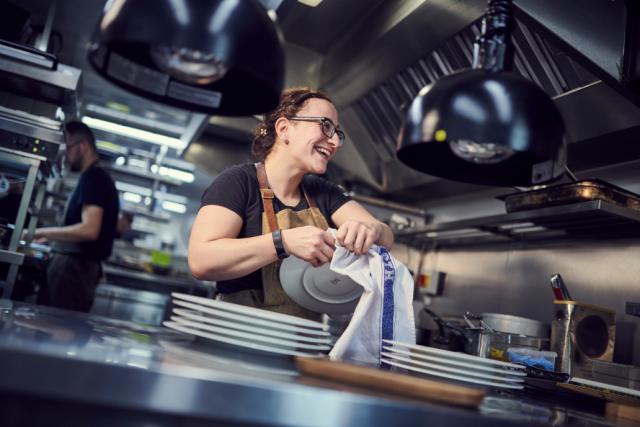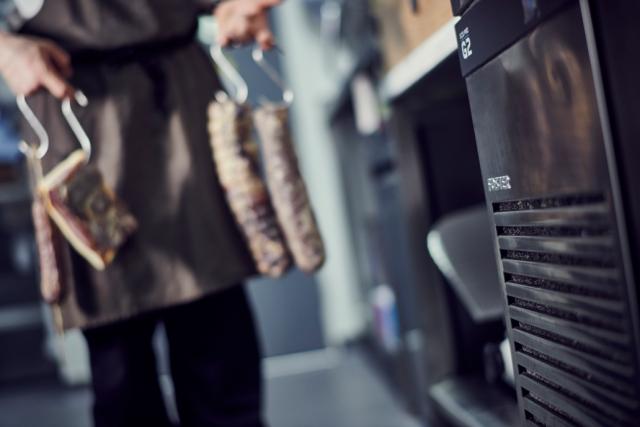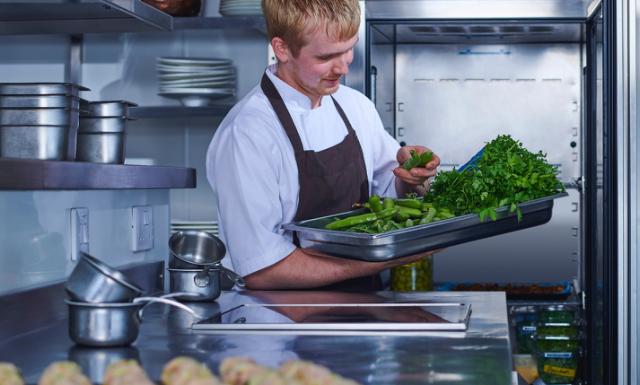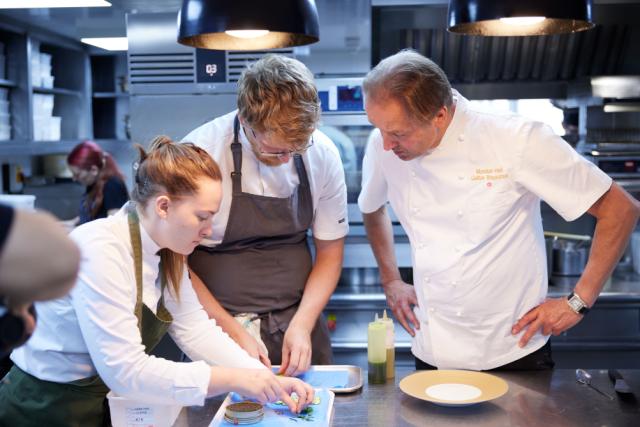
Storing Fish, Meat and Poultry Safely
on a Commercial Scale
Food-poisoning bacteria can grow and multiply on some types of food more easily than others. Unfortunately, fish, meat and poultry are among those in this high-risk group. Harmful bacteria begin to develop in raw meat from the moment an animal is slaughtered, making storage a time-sensitive process.

Bacteria multiplies fastest in the temperature ‘danger zone’, which is between 5°C and 63°C. As a result, it’s particularly important to take fish, meat and poultry out of this temperature zone as quickly as possible.
There’s also the issue of contamination, whereby non-high-risk foods like fruit and vegetables become hazardous through contact with high-risk foods. Add to this the importance of ensuring that meat is cooked thoroughly, and using these ingredients properly becomes a highly complex process.
Safe and appropriate storage can be a big challenge for commercial operations, but food safety is of the utmost importance in these environments.
Read on to learn exactly how to store food in the fridge for commercial operations.
Prepping meat, fish and poultry for storage
It’s important to practise good food safety from the moment food enters a kitchen. You should firstly be aware of its temperature and what it comes into contact with from surfaces to other foods. If the temperature is above safe food storage levels, do not accept the delivery as the food could already be unsafe and potentially hazardous.
Ensure that all meat, fish and poultry is in sealed containers to stop meat juices contaminating other foods. Cling film is useful for protecting food but, like many things, it needs to be used correctly. Not every type of cling film is suitable for use with all foods so check the description on the box to see what foods it can be used with. If possible, however, vacuum-packed meat is always best.
Next check the temperature of produce as soon as it arrives and refrigerate or freeze raw foods immediately. Fresh poultry, fish, ground meats and organ meats can be frozen up to two days after purchase/receipt. Beef, lamb and pork should be frozen within three to five days. If freezing meat and poultry in its original packaging for more than two months, you should place another layer of wrapping around them using airtight plastic wrap or plastic freezer bags.
You should ensure your fridge is cold enough to prevent food-poisoning bacteria from multiplying and growing, between 0ºC and 5ºC is recommended. It’s also important to keep your fridge clean - washing it regularly both internally and externally.


Storing meat in a commercial fridge
Those storing raw meat commercially should ensure that the fridge is never overloaded, as this can mean the temperature rises beyond the safe temperature zone (more than 5°C). This happens when food blocks the cooling unit inside the refrigerator. Restaurant fridges tend to have fans in them to distribute cold air as evenly as possible.
Too much food can also mean the fridge door does not close, which also affects the internal temperature. If your fridge doesn't have a built-in thermometer you should buy a fridge thermometer to monitor its temperature. Remember that the optimum temperature for storing meat is around - 0-5°C.
Air should also be able to circulate around the food, and overcrowding can impact this.
New stock should always be placed behind old stock in your commercial meat refrigerator. This encourages the correct stock rotation method of using ingredients in date order.
It’s important to note that the guidance for meat storage can depend on the type of meat, fish or poultry you're working with. Where rules are different for each, specific guidance will be given later in this article.
Where should meat be kept in the refrigerator?
The position of meat within a fridge may vary depending on the size of your fridge and the kind of operation you run.
In large commercial refrigerators and cabinets, meat, fish and poultry should be kept on the bottom shelf of the fridge (in domestic situations salad is often stored at the bottom of the fridge, but this is not good food safety practice). There are two reasons for this. The first is to stop juices dripping down and contaminating other foods. Some kitchens even have separate fridges for different types of produce.
The second reason is that the bottom of the fridge is where it is coldest, as cold air falls. It’s also the least likely area to lose heat when the door is opened and closed.
As a general rule, raw food should be stored below cooked food. Therefore, be sure to store raw products on the lower shelves of the refrigerator, below cooked products.


At what temperature should I store the meat?
Raw meat should be stored between -2°C and +2°C.
All carcass meats should be unwrapped and hung so that air can circulate around them, ideally at 1°C in a standard fridge and 3°C in a walk-in refrigerator.
Individual meat cuts such as steaks, chops and ground meat should be kept in covered containers between 2°C and 4°C.
Fresh fish and seafood should be stored between -1°C and +1°C.
The operating temperature of a general storage fridge, where a range of high-risk chilled food is stored, must be set to operate at a temperature between 1°C and 4°C. This ensures that high-risk food can be maintained at the legally required 8°C or below.
Most commercial fridges tend to keep a temperature of around 2°C and fridge and food temperatures should be checked at least twice a day.
How long can you keep meat in the fridge?
Short and long-term meat storage times depend on the type of meat you're refrigerating. As a general rule:
- Raw ground meats - 1-2 days
- Poultry - 1-2 days
- Seafood - 1-2 days
- Raw roasts, steaks and chops of beef, veal, lamb and pork - 3-5 days
- Cooked meats (inc. poultry and seafood) 3-4 days


Is it possible to freeze meat on a commercial scale?
Many restaurants and other catering businesses invest in blast freezers to freeze meats quickly and effectively. This allows meats to be as fresh as possible when prepared and served.
Meats should be frozen at a minimum temperature of -18°C. This a minimum required by UK law to protect customers from harmful bacteria and the illnesses they can cause.
How long can I freeze raw meats for?
- Beef - 12 months
- Beef mince - 6 months
- Veal - 10 months
- Lamb - 12 months
- Pork - 8 months
- Whole chicken - 12 months
- Chicken pieces - 9 months
- Sausage - 6 months
Fish should be stored at -30°C, which will keep it fresh for 6 months.


Thawing meat, fish and poultry
As soon as raw or cooked meats begin to thaw and become warmer than 4.5°C, bacteria that may have been present before freezing can begin to multiply and grow. Thawing is best carried out at temperatures between 10°C and 15°C. There are a variety of methods for thawing, each detailed below:
Refrigerator thawing
- Frozen poultry (especially large birds) can take 24 hours to thaw for every 2kg
- Ground meat or boneless chicken breasts take 24 hours
- After thawing in the fridge, ground meats, stews, poultry and seafood are safe for an additional 24 hours before cooking
- Cuts of beef, pork or lamb will be safe for 3 to 5 days
Cold-water thawing
For faster thawing, take frozen food in its leak-proof package or plastic bag and submerge in cold water - changing the water every 30 minutes - until thawed.
- 0.5kg of meat should thaw in 1 hour
- 1.5-2kg packages may take 2 to 3 hours
Cook any meat thawed in this way immediately.
Microwave thawing
To thaw in a microwave, ensure you use the 'defrost' setting. Be sure to make sure that the food defrosts evenly and does not begin to cook.
After thawing in the microwave, cook meat immediately. Foods thawed in the microwave should be cooked before refreezing
Cooking without thawing
It is safe to cook most foods from frozen. You must ensure that the meat is cooked thoroughly by using a meat thermometer. Cooking can take up to 50% longer than the recommended time for fully thawed or fresh meat and poultry.
Meat and fish should be thawed slowly if possible. Food that has been frozen and thawed won't last as long as fresh meat, so the window to cook and consume it is smaller. Many businesses use a controlled thaw cabinet to simplify this process.
Why is safe meat storage so important?
Meat can carry bacteria or become a home for bacteria introduced from around it. As such, it’s essential to inhibit the growth and spread of bacteria on the meat we eat. To do this we cook, refrigerate and freeze our meat. But even these methods are easy to perform poorly. This can allow bacteria to breed in 'windows of opportunity' - when temperature and exposure are just right.
A key issue is that we can't always see or smell bacteria, so we can't tell if refrigerating or thawing has protected us when we cook the meat. This is why it’s essential to follow general food safety guidelines, implement strict processes and teach your staff about correct food safety. This way you will protect yourself, your team and your customers from illness - which can in turn impact your business.


Additional tips for storing meat, fish and poultry on a commercial scale
Here is a handy list of additional tips for storing meat on a commercial scale:
- Enforce the 'first in, first out' rule for correct stock rotation
- Store meat at the bottom of your freezer or fridge, away from other food types
- Use clear, air-tight containers and/or wrap
- Clearly label your meats with the 'what' and the 'when' information
- Check your refrigerator thermometer often
- Avoid contact with stored meats to maximise hygiene when handling food
- Don't overfill your fridge
- If in doubt, throw it out. The cost of the cut is not worth the risk to your business.
Want to know more?

10 simple guidelines to help you store products safely in your refrigerator

Safety and quality: why food temperature matters

Training Staff on Food Hygiene Regulations


